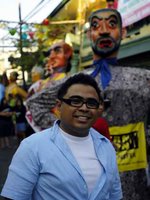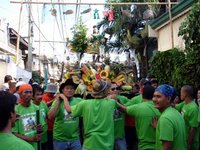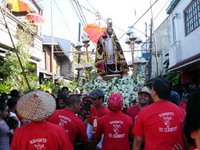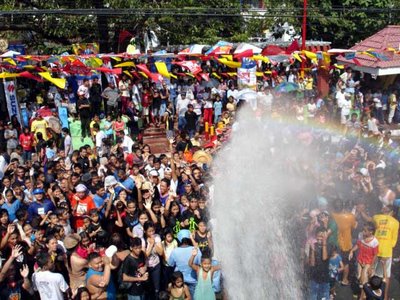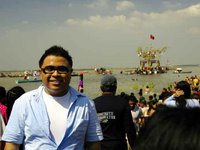From Nemiranda, we were able to ask for directions to the petroglyphs. We were on the right track since the Angono Petroglyphs are inside the Eastridge Golf Club. So from his studio, it was a three-kilometer drive up and down a steep road. At the guard house, you simply say you're on your way to the petroglyphs. The site is close to the Antipolo entrance of the golf club. You had to enter through a tunnel cut into the hill to get to the other side where the petroglyphs are located.
The Angono Petroglyphs were discovered by Botong Francisco in 1965. Dating back to 3000 B.C., the 127 human and animal figures depicted are said to be the oldest works of art in the Philippines. They are actually at the boundary of Angono, Binangonan and Antipolo. I guess these art works really bolster the claim of the area as the center of art in the country. Neighboring Binangonan is host to the residence of national artist for painting Vicente Manansala (who was from Macabebe, Pampanga), which is a declared National Historical Landmark of the NHI.
Sadly, there are traces of vandalism near some of the figures. It just shows how some Filipinos value their heritage. These rock carvings are National Cultural Treasures and are under the care of the National Museum. In 1996, they were included in the World Monuments Watch as one of the 100 Most Endangered Sites in the world.
I realized that the fact that there was no obvious signage to the place served as a temporary protection since only people who appreciate it go out of their way to look for it. If it was popularized without the proper security and all, some shallow-minded people might think it a novel idea to carve their names beside the petroglyphs! So I guess it's better that way for the meantime.
From there, we proceeded back down. Our last stop was the Catholic Cemetery to check out the final resting places of Botong Francisco and Lucio San Pedro. I laud the local community for regulary holding tributes for them there. The tombs are actually ordinary raised vaults and I feel that Angono, with its artists community could improve them and transform them into real monuments.
Anyway, that's it for now. Where am I off to next?
Part 1: Viva San Clemente! Higantes of Angono, Rizal
Part 2: Angono is the Art Capital of the Philippines
The Angono Petroglyphs were discovered by Botong Francisco in 1965. Dating back to 3000 B.C., the 127 human and animal figures depicted are said to be the oldest works of art in the Philippines. They are actually at the boundary of Angono, Binangonan and Antipolo. I guess these art works really bolster the claim of the area as the center of art in the country. Neighboring Binangonan is host to the residence of national artist for painting Vicente Manansala (who was from Macabebe, Pampanga), which is a declared National Historical Landmark of the NHI.
Sadly, there are traces of vandalism near some of the figures. It just shows how some Filipinos value their heritage. These rock carvings are National Cultural Treasures and are under the care of the National Museum. In 1996, they were included in the World Monuments Watch as one of the 100 Most Endangered Sites in the world.
I realized that the fact that there was no obvious signage to the place served as a temporary protection since only people who appreciate it go out of their way to look for it. If it was popularized without the proper security and all, some shallow-minded people might think it a novel idea to carve their names beside the petroglyphs! So I guess it's better that way for the meantime.
From there, we proceeded back down. Our last stop was the Catholic Cemetery to check out the final resting places of Botong Francisco and Lucio San Pedro. I laud the local community for regulary holding tributes for them there. The tombs are actually ordinary raised vaults and I feel that Angono, with its artists community could improve them and transform them into real monuments.
Anyway, that's it for now. Where am I off to next?
Part 1: Viva San Clemente! Higantes of Angono, Rizal
Part 2: Angono is the Art Capital of the Philippines





